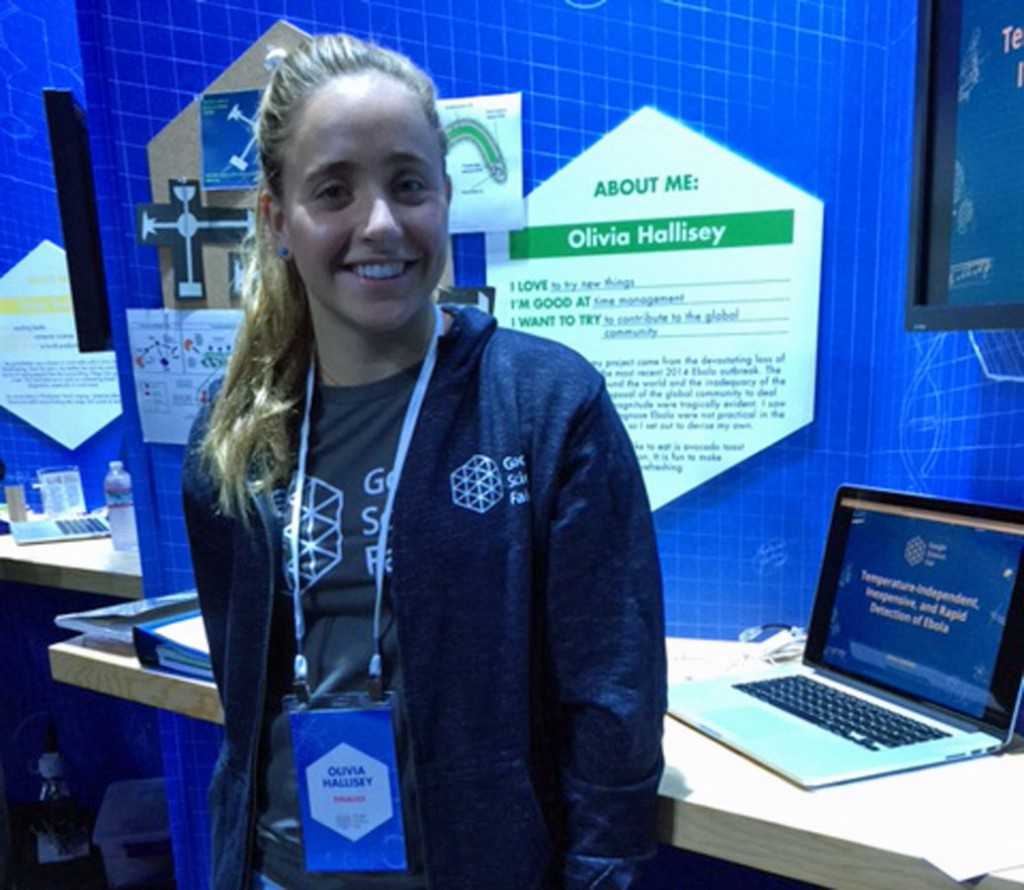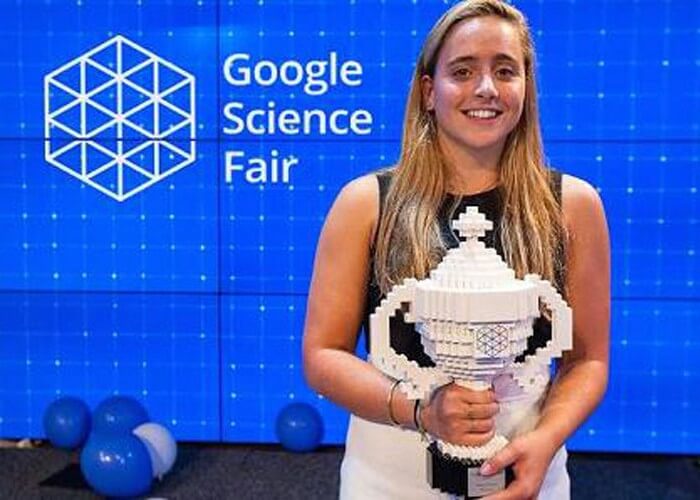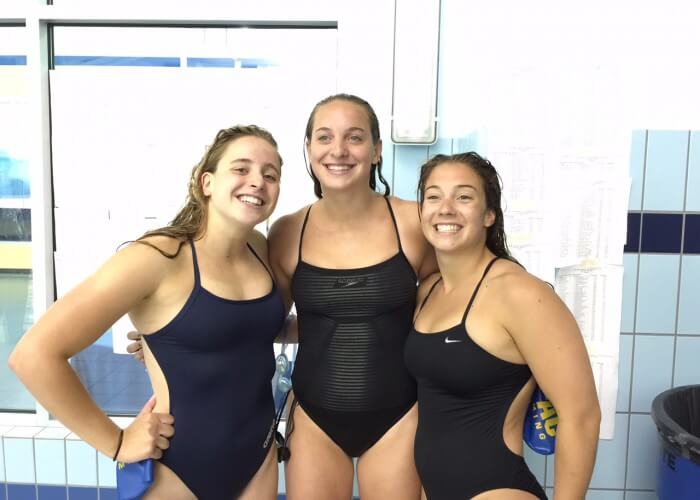How Swimming Is Helping Olivia Hallisey Save the World From Ebola

By Jeff Commings, Swimming World Senior Writer
It’s quite possible that the name Olivia Hallisey will roll off the tongue as easily as Marie Curie in a few years. That is not an overstatement. Where Curie made a landmark discovery of radioactivity and became a household name, Hallisey soon could be known as the woman who was instrumental in eradicating the ebola virus from the planet.
In September, Hallisey won the Grand Prize at the Google Regional Science Fair for developing a test for ebola that would not require refrigeration. This would allow medical staff to go into remote areas of Africa – where the disease is most prevalent – and test for ebola without the need for bulky refrigerators to store the equipment.
About a month later, she was on Time Magazine’s list of the 30 Most Influential Teens with the likes of Katie Ledecky, Jaden Smith and Malala Yousafzai.
Hallisey, 17, possesses more than a sharp mind. She represents the Chelsea Piers Aquatic Club in Connecticut, primarily in the individual medley and distance freestyle events. In between her rigorous schedule at Greenwich High School and her afternoon swim practice, she took time to talk about her newfound popularity.
Swimming World: What do you make of being in the spotlight in the past couple of months?
Olivia Hallisey: It didn’t really sink in for a bit, but now (I’m grateful for) all the opportunities that are presenting themselves. I really want to make sure that I’m able to use all the opportunities to send a positive message and reach other people out there. I think it’s a big responsibility, but I’m really enjoying it.
SW: What kind of opportunities that are coming your way?
Hallisey: It’s educational opportunities, talking to kids and young girls about getting involved in science and trying new things. Trying to show them that everyone’s capable of excelling at whatever they put their minds to.
SW: Did you think this something that would come of your discovery and the subsequent recognition of it?
Hallisey: I wasn’t (taking) the class for any recognition. I’m just doing it because it’s what I’m interested in. I think it’s great that I’m able to use the recognition and show other people what they are capable of doing and to inspire them.
SW: Are you finding that there aren’t a lot of girls in science?
Hallisey: I definitely notice that, but I see in my class that there are a lot of girls and they’re doing amazing things that are equal to or better than the boys. When it comes to science, it doesn’t matter what age you are or what gender you are, it’s about what you are trying to discover or explore. That’s the whole message of the Google Science Fair, that you should try something, no matter who you are or where you’re from.
SW: What was more exciting: Winning at the Google Science Fair or being on Time Magazine’s list with Katie Ledecky?
Hallisey: I think they are both … I can’t even fathom either of them at all. I definitely look up to Katie Ledecky so much, and also when I won Google it was a crazy experience. I can’t really rate them. They are incredible recognitions.
SW: Let’s talk about the development of this test. How did it evolve from an idea into reality?
Hallisey: I’m in a science research class at school, so I had the idea initially there. From there, I was really set on making it happen. I think that is what swimming has shown me. If you apply yourself and try, good things will come out of it. I just wanted to put all my effort into it and hopefully I would be able to succeed.
SW: What was the most challenging part of creating a testing procedure for ebola that didn’t require refrigeration?
Hallisey: Probably the most challenging part was getting the materials and finding the right materials for it, because a lot of the companies weren’t willing to sell me the chemicals I needed. Also, it was difficult to find the right paper to make the test on.
SW: How long did this project last, from conception to submitting your findings?
Hallisey: It was probably around six months. It was a class in school, but I also had to come in on weekends as well and work on it. It was pretty rigorous to get it all done.
SW: I’m sure it was havoc on your life, especially in terms of trying to get to swim practice.
Hallisey: Yeah. For me, swimming makes me have good time management. If I have swim practice, I just build my whole day around it. It’s also real important for me as a stress reliever and also to organize my thoughts. It never interfered with swimming.
SW: How does the test work?
Hallisey: If the ebola antigen is present, then there will be a color change (on the test paper), so it’s like a pregnancy test for ebola. It’s universal. It can be used anywhere. There’s no language barrier. Also, it’s temperature-independent, which means it doesn’t need to be refrigerated. That’s a current problem with the current method.
SW: Have you been contacted by the Centers For Disease Control or another agency about putting this test to use?
Hallisey: I still have to continue formalizing this test, but I definitely look forward to talking with those companies. That is my ultimate goal, to see this test being used eventually and helping people.
SW: How long have you been interested in science?
Hallisey: My grandfather was a doctor, so I think that was the beginning for me. I would go to his office, and he would make (his patients) so happy and give them hope. That started it early for me to believe that I wanted to do something like him.
SW: What was the first major science project that you created that made you feel that this was a path you wanted to take?
Hallisey: Not me personally, but my older brother was also in a science research class, and he loved the class and loved the experience. I remember looking up to him. So, that’s when I realized I loved science and also wanted to be in the research class.
SW: Did the demands of projects such as this ever make you wonder if you continue to be a good swimmer and follow this path of being a good science?
Hallisey: Swimming is what made it possible for me to keep up with the demands. Swimming has made me more disciplined and have time management skills, and look at things from a different perspective. My coach (Jamie Baron) does a good job of supporting us in our outside interests and make it possible that everyone can be dedicated to swimming.
SW: You swam a lot of best times this past summer (including a 5:11.05 in the 400-meter IM). What’s the next short-term swimming goal for you?
Hallisey: I really want to break 5:00 in my (500-yard freestyle) at (the Tom Dolan Invitational) this winter, so I’m hoping to do that. These experiences have taught me that nothing is ever going to be perfect, so I really love being able to go to practice. It’s hard for me to miss a day of practice because I’m away, but it taught me that you have to be able to adapt to the situation and work through things that aren’t perfect.
SW: I understand you’ve also got a trip to Paris coming up.
Hallisey: That is another opportunity that came up because of the science project. It’s a trip to talk about my experiences and present the work more.
SW: That’s nice on a global scale. I think it’s shown how important this discovery has become.
Hallisey: I think Google has done a great job with that because (the company is) a global platform. I’m working with the people that are sponsoring the Paris trip with a charity that’s offering education for young girls and young mothers, and that’s what I want to focus on: inspiring other young women all around the world.
SW: Are there other ideas you have that you want to get into action pretty soon?
Hallisey: In races, even if you have a good race, there’s something you can improve. With this (ebola) test, that’s about making it work with saliva and also applying it with other tests. There’s more work with this test that I want to do.
Read more about Hallisey’s research project





